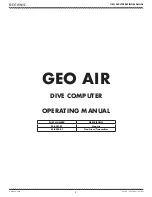
17
17
Appendix E:
Correction Factors for Non-Standard Conditions
The AXD 550 is a differential pressure instrument.
When it is connected to a Pitot-static probe, it can
be used to measure velocity. When a Bernoulli’s
equation is applied to the Pitot-static probe, the
resultant equation has the form V(ft/min) = 4005
[P(in H
2
O)]
1/2
when the density of the air is 0.075
lb/ft. The velocity values displayed by the AXD
550 are the actual velocities
only
if the density
where the Pitot probe measurements are being
taken is 0.075 lb/ft
2
. Otherwise, a correction step
must be performed to obtain a correct value. Listed
below in
decreasing
order of accuracy are
methods for determining a correction factor.
Note
: In the United States, the barometric
pressure reported by the National Weather
Service is corrected to sea level and,
therefore, cannot be used unless your
measurements are taken at sea level. The
preferred method is to use the atmospheric
pressure at the location of the
measurement. If you do not have access to
that value, then Method 3 in this appendix
can be used. This method is most accurate
when the pressure reported by the national
weather service is 29.92 in Hg due to the
assumption of standard density.
Method 1
If you have the absolute pressure, temperature and
relative humidity, record the differential pressure
from the AXD 550, the absolute pressure, the
temperature, and the relative humidity at the
measurement location. Compute the density using
the techniques used in the 1993 ASHRAE
fundamentals handbook. With the density and the
differential pressure, use the formula for Pitot
probes also found in that handbook to compute the
actual velocity.
Method 2
If you have the absolute pressure and the
temperature, you have two options.
a) Record the displayed velocity measurement
along with the absolute pressure and
temperature. Convert to units of °F and in Hg
if the temperature and pressure were not taken
in those units. To obtain actual velocity, use
Equation 1 in this appendix to calculate the
correction factor and multiply the velocity
reading by that factor.
b) If using the equation is not convenient, the Air
Pressure vs. Air Temperature chart in this
appendix can be used to determine the
correction factor. However, inaccuracies can
result from using the graphical technique
instead of a direct calculation to obtain actual
velocity.
Method 3
You can use this method if you know the altitude
above sea level and the air temperature but are
unable to determine the absolute pressure. Using
the AXD 550 Density Correction Factors chart,
find the appropriate correction factor value.
Multiply the displayed value by the value in this
chart to get the “corrected” value.
Eq. 1:








































